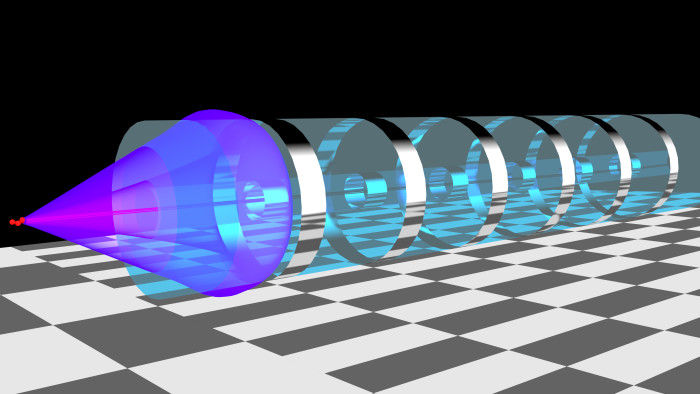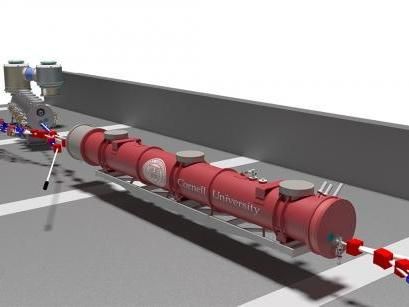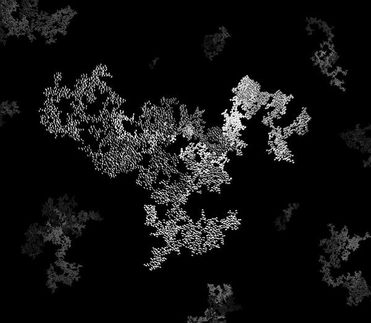Light bending material facilitates the search for new particles
Particle physicists have a hard time identifying all the elementary particles created in their particle accelerators. But now researchers at Chalmers University of Technology have designed a material that makes it much easier to distinguish the particles.

Cherenkov light cone created by particles moving through a metamaterial designed by Chalmers’ researcher Philippe Tassin and colleagues. The material is constituted by silver cylinders, a few tens of nanometers thick, embedded in a nonconductive material.
Vincent Ginis
To investigate the matter's smallest constituents, physicists have particles colliding with each other at very high speeds, for example in the particle accelerator LHC at Cern. The collisions create bursts of common and rare particles, all invisible to the eye.
To identify them researchers need to detect the cone of light – known as Cherenkov radiation – formed around a particle that travels faster than light in a transparent material.
Is that possible? Yes, it is. Nothing can travel faster than the speed of light – in vacuum. But in materials light propagates slower and, hence, particles may be moving faster than light without violating the laws of physics. Cherenkov radiation is the optical phenomenon corresponding to the sonic shock wave formed around an object moving faster than the speed of sound. The angle of the Cherenkov light cone, i.e. its sharpness, provides the particle physicists a measure of the velocity of the particle which helps them to identify the particle.
The problem is that the light cone angle has a limit – all particles with high momentum (mass x velocity) generate light cones with the same angle. Hence, these particles are indistinguishable.
Now Chalmers researcher Philippe Tassin and his colleagues at the Free University of Brussels have designed a material that manipulates the Cherenkov cone so that also particles with high momentum get a distinct light cone angle too. The work is on the cover of this week’s issue of the journal Physical Review Letters.
“The result is that even particles with large momentum can be efficiently separated and identified,” said Philippe Tassin.
The method that they used to design the new material is known as transformation optics. It is a fairly new and very fruitful combination of Einstein's relativity theory – with its curved space-time – and optics.
Carefully calculated variations of the material's refractive index causes the light to experience the material as being curved and, therefore, it behaves differently from what we are used to. In the Chalmers scientists' material, Cherenkov radiation experiences the material as stretched in two different directions, which gives rise to light cones with distinct angles.
Through their work, Philippe Tassin and his colleagues also demonstrated more in-depth opportunities with transformation optics.
“So far, transformation optics has mainly concerned changing the light rays paths through a material. Now, we show that it is also possible to influence the generation of light. As an example, we have solved the problem of Cherenkov light cones for particles of large momentum,” explains Philippe Tassin.
Transformation optics may, for example, also be used to design materials that concentrate or absorb light very efficiently, which would be useful for solar energy. Other materials designed via transformation optics are promising for simulating cosmological phenomena such as black holes.
The results derive from a collaborative research effort conducted by Chalmers and the Vrije Universiteit Brussel, and the project was funded by the Area of Advance of Nanoscience and Nanotechnology at Chalmers University of Technology and the Research Foundation-Flanders in Belgium.
Most read news
Organizations
Other news from the department science

Get the analytics and lab tech industry in your inbox
By submitting this form you agree that LUMITOS AG will send you the newsletter(s) selected above by email. Your data will not be passed on to third parties. Your data will be stored and processed in accordance with our data protection regulations. LUMITOS may contact you by email for the purpose of advertising or market and opinion surveys. You can revoke your consent at any time without giving reasons to LUMITOS AG, Ernst-Augustin-Str. 2, 12489 Berlin, Germany or by e-mail at revoke@lumitos.com with effect for the future. In addition, each email contains a link to unsubscribe from the corresponding newsletter.

























































